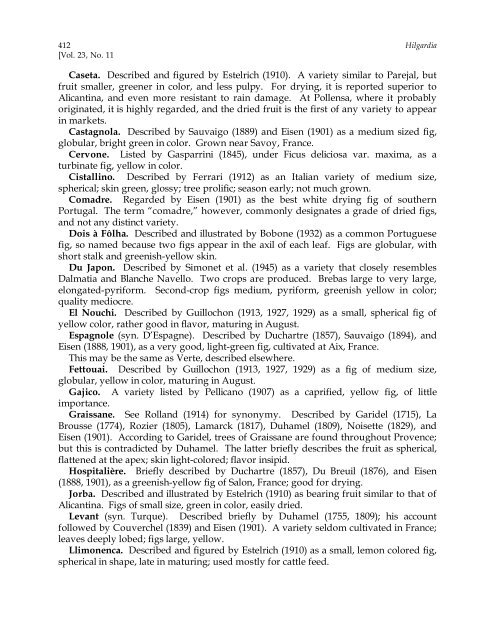Fig Varieties: A Monograph - uri=ucce.ucdavis
Fig Varieties: A Monograph - uri=ucce.ucdavis
Fig Varieties: A Monograph - uri=ucce.ucdavis
You also want an ePaper? Increase the reach of your titles
YUMPU automatically turns print PDFs into web optimized ePapers that Google loves.
412 Hilgardia<br />
[Vol. 23, No. 11<br />
Caseta. Described and figured by Estelrich (1910). A variety similar to Parejal, but<br />
fruit smaller, greener in color, and less pulpy. For drying, it is reported superior to<br />
Alicantina, and even more resistant to rain damage. At Pollensa, where it probably<br />
originated, it is highly regarded, and the dried fruit is the first of any variety to appear<br />
in markets.<br />
Castagnola. Described by Sauvaigo (1889) and Eisen (1901) as a medium sized fig,<br />
globular, bright green in color. Grown near Savoy, France.<br />
Cervone. Listed by Gasparrini (1845), under Ficus deliciosa var. maxima, as a<br />
turbinate fig, yellow in color.<br />
Cistallino. Described by Ferrari (1912) as an Italian variety of medium size,<br />
spherical; skin green, glossy; tree prolific; season early; not much grown.<br />
Comadre. Regarded by Eisen (1901) as the best white drying fig of southern<br />
Portugal. The term “comadre,” however, commonly designates a grade of dried figs,<br />
and not any distinct variety.<br />
Dois à Fôlha. Described and illustrated by Bobone (1932) as a common Portuguese<br />
fig, so named because two figs appear in the axil of each leaf. <strong>Fig</strong>s are globular, with<br />
short stalk and greenish-yellow skin.<br />
Du Japon. Described by Simonet et al. (1945) as a variety that closely resembles<br />
Dalmatia and Blanche Navello. Two crops are produced. Brebas large to very large,<br />
elongated-pyriform. Second-crop figs medium, pyriform, greenish yellow in color;<br />
quality mediocre.<br />
El Nouchi. Described by Guillochon (1913, 1927, 1929) as a small, spherical fig of<br />
yellow color, rather good in flavor, maturing in August.<br />
Espagnole (syn. D’Espagne). Described by Duchartre (1857), Sauvaigo (1894), and<br />
Eisen (1888, 1901), as a very good, light-green fig, cultivated at Aix, France.<br />
This may be the same as Verte, described elsewhere.<br />
Fettouai. Described by Guillochon (1913, 1927, 1929) as a fig of medium size,<br />
globular, yellow in color, maturing in August.<br />
Gajico. A variety listed by Pellicano (1907) as a caprified, yellow fig, of little<br />
importance.<br />
Graissane. See Rolland (1914) for synonymy. Described by Garidel (1715), La<br />
Brousse (1774), Rozier (1805), Lamarck (1817), Duhamel (1809), Noisette (1829), and<br />
Eisen (1901). According to Garidel, trees of Graissane are found throughout Provence;<br />
but this is contradicted by Duhamel. The latter briefly describes the fruit as spherical,<br />
flattened at the apex; skin light-colored; flavor insipid.<br />
Hospitalière. Briefly described by Duchartre (1857), Du Breuil (1876), and Eisen<br />
(1888, 1901), as a greenish-yellow fig of Salon, France; good for drying.<br />
Jorba. Described and illustrated by Estelrich (1910) as bearing fruit similar to that of<br />
Alicantina. <strong>Fig</strong>s of small size, green in color, easily dried.<br />
Levant (syn. Turque). Described briefly by Duhamel (1755, 1809); his account<br />
followed by Couverchel (1839) and Eisen (1901). A variety seldom cultivated in France;<br />
leaves deeply lobed; figs large, yellow.<br />
Llimonenca. Described and figured by Estelrich (1910) as a small, lemon colored fig,<br />
spherical in shape, late in maturing; used mostly for cattle feed.
















![Fig Trees in North Carolina [Archive] - IDigMyGarden ... - Figs 4 Fun](https://img.yumpu.com/26905320/1/190x245/fig-trees-in-north-carolina-archive-idigmygarden-figs-4-fun.jpg?quality=85)